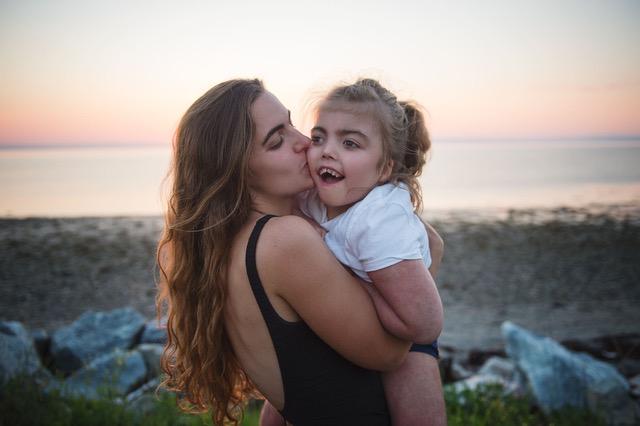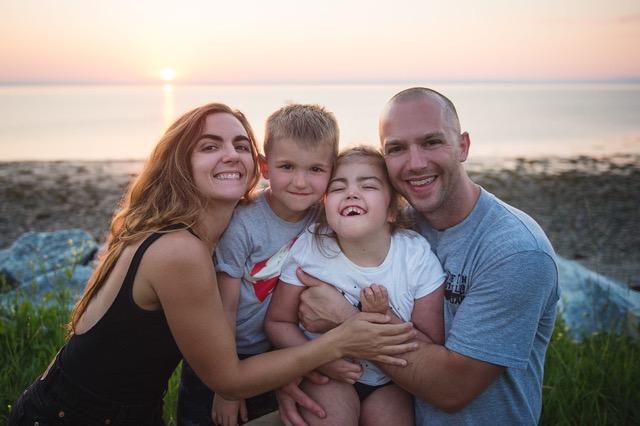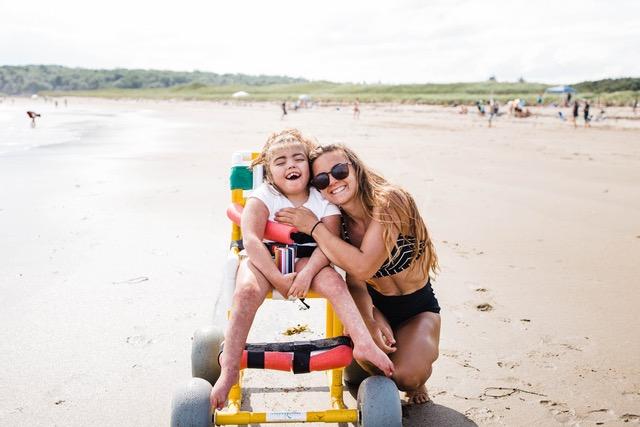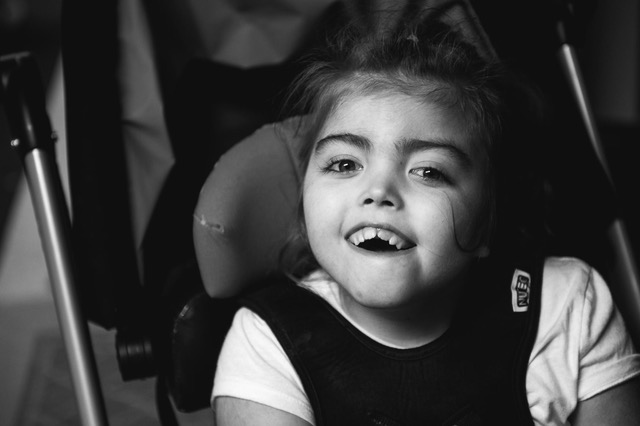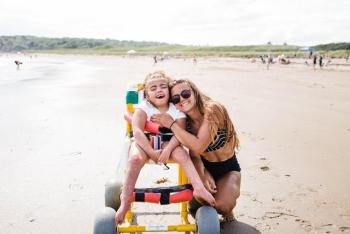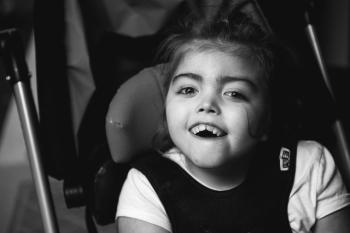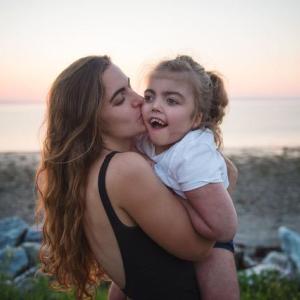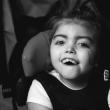Starting a business to help cover rare genetic medication costs helps Rockport family
ROCKPORT — If it was not for the online marketplace Poshmark, 33-year-old Rockport resident Sierra Jackson and her husband, Dana, would almost certainly have to skip buying at least some medications for their eight-year-old daughter, Lila.
The family, which includes younger brother Jude, spends near countless hours each week providing care for Lila, who her mother described as a six-month-old in an eight-year-old’s body.
Sierra, a University of Maine at Augusta degree recipient, is unable to maintain traditional employment, while Dana is employed by Spectrum Cable.
Not long after Lila’s birth, her parents learned they had an incredibly unique daughter — literally.
The day after her birth, Lila fell ill and was rushed to Eastern Maine Medical Center in Bangor.
“The doctors noticed Lila’s had low tones, small ears, and simian crease on her hands,” Sierra recalled.
Lila was diagnosed with a genetic disorder so rare it has no name and is entirely unique to her.
“There hasn’t been a human born with her exact genetic disorder and there probably won’t be another human born with her exact genetic disorder,” Sierra said. “Her geneticist told us once that our chances of winning the [lottery] was better than conceiving Lila with this rare genetic disorder.”
In Lila’s eighth and X chromosomes, there are 11 genes deleted on the eighth chromosome, a translocation of Xq chromosome onto Chromosome 8, a duplication of Xq and mosaicism.
“She essentially has two cells with different [genotypes] — which the geneticist believes is why Lila’s genetic disorder isn’t as severe as it could’ve been,” said Sierra. “Basically her body was trying to ‘cure’ itself by duplicating what it had ‘lost’ (but merely moved to chromosome 8).”
Though there are other people with similar deletions on Chromosome 8, those people do not have the translocation, duplication or mosaicism aspects.
In the spring and fall, Sierra says she and Lila make a three-hour round-trip trek to Portland three times per month to see 10-12 specialist doctors and combine appointments to reduce the days spent traveling to Portland. In the winter and summer, the journey only needs to be made once a month.
Lila regularly sees a geneticist, neurologist, pulmonologist, gastroenterologist, endocrinologist, audiologist, otolaryngologoist and a special ophthalmologist. As needed, she sees a cardiologist and urologist, in addition to having her hearing screened and visiting a sleep clinic every few years. Lila also has ankle-foot orthosis so a specialist is seen for that, as well. A cannabis doctor in Falmouth is visited since cannabis serves as a seizure medication for Lila. Second opinions are sometimes sought regarding her seizures and genetic disorder at the Boston Children’s Hospital. Of course, Lila needs to make routine visits to her pediatrician numerous times throughout the year.
Lila takes seven to eight medications daily, some administered twice-a-day, with another three to five medications set aside for emergencies. Since she cannot swallow pure liquids, medicines are administered via syringe and a G-tube, the latter also being used for her formula feeds.
Three times a week, Lila has a physical therapy session with two of the sessions being at school. She sees a speech therapist and occupational therapist twice-a-week, respectively, and occasionally visits a speech therapist for to get help for eating by mouth.
Each week, Lila experiences 10-12 seizures, nearly double what she once experienced. Her mother, Sierra, said she thinks the increase is due to natural changes Lila’s body is going through right now, though the family is hoping to receive definitive reasoning this spring during a trip to the Boston Children’s Hospital.
The first seizure for Lila came when she was nine months old and caught her mother completely off guard.
“I was alone with her, getting ready to feed her,” Sierra recalled. “One moment she was fine, I turned my back to prepare a meal and turned back around to serve her and she was gone.”
Sierra remembers looking at her nine month-old daughter’s frozen body, head down and eyes averted to one side. She recalls the terror she felt in those moments and the scramble to call 911 operators, but after that her memory is foggy due to the francticness of the situation. An ambulance may have arrived at the house, or Sierra may have rushed her daughter to the emergency room herself. Everything that would transpire next remains unclear in Sierra’s mind.
What is clear, though, is Lila’s seizures have matured as Lila has also matured. Lila now experiences full clonic tonic grand maul seizures, affecting her entire body with muscles tightening in her hands, feet and legs. At times, Lila will have a hand in her hair as she scratches her head and a seizure will begin. Lila will end up tightly clutching her own hair, essentially pulling her hair, with a grasp so tight Sierra will struggle to open Lila’s clenched hand.
There are other moments where doctors believe Lila will briefly go blind or see something scary, scream “bloody murder” — as her mother says — and begin experiencing a seizure lasting 30-60 seconds.
Once the seizure is finished Lila’s entire body generally aches, there usually is some crying and then a long period of sleeping.
Due to the constant care Lila needs, Sierra’s only option, at least at this point, is to be self-employed so she can best provide the care Lila needs.
Lila currently has two nurses covering a weekday 8 a.m. to 4 p.m. shift, though one of the nurses will be leaving in the summer with no replacement in sight.
“Our nurses take on the medical aspect (in the home and at public school) so I can focus on advocating, ordering health supplies/equipment, working, being a typical mom to Jude and experiencing motherhood with Lila,” she stated.
On top of directly providing care for her daughter, there are times when Sierra spends hours a day, several days in a row, on the phone with insurance companies. There are days when she spends over two hours on hold with one insurance company, only to then be told another insurance company is at fault. She will then play the seemingly never-ending game of calling both insurance companies, spending near-countless hours on hold, and speaking to an outrageous amount of representatives before the billing issue has been resolved.
Despite all the work she has to do on her own, Sierra says the most important benefit she receives from the nursing assistance is the chance to be more of a mother to her children.
“Before our nurses, I was Lila’s nurse, not her mom,” she said. “I wasn’t cuddling her. Playing with her. Enjoying life with her. I was constantly caring for her health. Changing diapers, administering medication, suctioning, checking her vitals. Bringing her to the hospital and doctor [appointments] by myself at times. In the first 3.5 years of Lila’s life, I didn’t really get to experience true motherhood, I was too busy being her nurse. Trying to keep her alive. Literally.”
Prior to Lila’s birth, Sierra was a self-employed photographer that traveled across the entire New England region for photography work. She continued to travel across the state once Lila was born, but had to convert to only being a local Midcoast photographer since it became too burdensome traveling across the state only to find out mid-way through the photography assignment Lila had been rushed to the emergency room with Sierra being left with no choice but to finish the assignment before hitting the road to be with her daughter.
“I felt guilty. Terrible. My first priority is Lila, so I gave up traveling and photographing to be there for her,” Sierra stated.
Sierra attempted to work a more quote-unquote regular job, but she usually was passed over for one reason or another.
Frustrated and having medical expenses, such as a $250-a-month bill for the much-desired cannabis medication, piling up, she began brainstorming additional self-employment options in order to cover the bills.
Ultimately, Sierra decided to try selling vintage clothing on Poshmark, a digital marketplace where people can buy and sell clothing, shoes and accessories.
Before long, Sierra found an abundance of success with the trendy digital space.
“I was making sales like crazy and was earning what I needed to pay for her medicine,” she said.
For her Poshmark store, Sierra curates vintage clothing across the state before cleaning, sewing and ironing the clothes. She then models the clothes for stock images to appear with the product listing before editing and uploading the photos alongside the product listing. When an item sells, it is up to her to package and mail the item.
“It’s a lot of work, but I enjoy it,” she stated, while noting nothing beats the feeling she gets knowing she sets her own schedule and is able to freely provide care for Lila as needed.
Thanks to her continuing success on Poshmark, Sierra has made it a mission this year to start giving back, since a wide variety people and organizations have generously assisted her family over the years.
“I wanted to give back to the ‘giving circle’ and that’s when I decided to start taking extra funds from my Poshmark sales and give back,” she said.
Each month this year, Sierra is setting aside anywhere from $100 to $200 to donate. Thus far, she has donated some leftover funds from her Poshmark sales to the Ronald McDonald House and the Make-A-Wish Foundation.
“We had to stay at the [Ronald McDonald House] in Bangor for nine days while Lila was in the NICU,” she said in a post on her clothing company’s Instagram page of the January donation. “They were so welcoming and giving to our family during the most difficult time in our life! I’m [so] blessed for this organization[,] they made it so I could stay close to Lila, while she healed in the hospital.”
Of the February donation, she noted on Instagram the Make-A-Wish Foundation provided the family with a trip to Disney World in Orlando.
“The vacation was such a blessing for my family,” she said on the social media website. “So many adventures and memories made [that are] now forever in my heart.”
In the future, she hopes to donate to other charities that have helped her family including Give Kids the World Village, the Epilepsy Foundation and the Robbie Foundation. She also wants to donate to environmental groups and to local food banks, churches and women’s shelters.
Like any other human, what the future holds for Lila remains unknown. For Lila, however, the future is murkier considering there is no precedent to follow.
“I try not to over plan, overthink or set unrealistic expectations,” Sierra stated. “I know that sounds a bit harsh, but that’s our reality when you have a child with a unknown genetic disorder. There’s no books or guidelines to follow. There’s no medical reports that can clarify or warn us of what’s to come in the future with Lila’s genetics disorder. So we’re walking blindly every day. Every month. Every year. Anything medical can pop up at any moment.”
For now, though, the Jackson family is clinging to every moment and creating time for everlasting memories that may seem small — cuddling, hand-holding or lunch and movie dates — to some, but to the Jackson family these memories are just as large as their other significant memories, like vacations.
“With Lila, I’ve learned to savor every moment, because you just never know,” Sierra said. “You never know when that ONE seizure could take her from us.”
Reach George Harvey at: sports@penbaypilot.com.
Event Date
Address
United States

